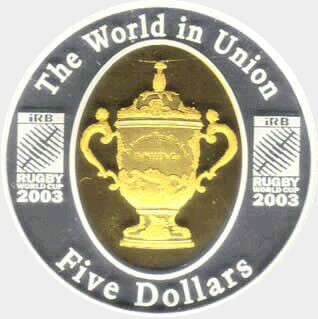



?
The Rugby World Cup 5 Dollar commemorative coin was released following the successful hosting of the event by Australia
in 2003. It was originally planned to held jointly with New Zealand, but a dispute arising from sponsorship led the Rugby
World Cup Limited to shift the event entirely onto Australian soil. This coin is struck in sterling silver but also has an
image of the Rugby World Cup Trophy which is gold plated. The
The 2003 Rugby World Cup took place in Australia between the 10th October and 22nd November. It was played around eleven different venues in Sydney, Gosford, Wollongong, Brisbane, Townsville, Melbourne, Perth, Canberra, Adelaide and Launceston. A total of 48 matches would be played in the group and knockout stages. The final would be held at the Telstra Stadium in Sydney.This would also be the first time that the Rugby World Cup would be using the bonus point system that is widely used in the southern hemisphere. The system encourages try scoring and rewards attacking teams. A bonus point is awarded if the team scores four or more tries regardless if they win or lose. The opening games of the tournament was staged at the Telstra Stadium in Sydney. It saw Australia beat Argentina by 24 points to 8. Australia won Pool A from Ireland and also produced the biggest win in the tournament against Namibia with a whopping 142-0 scoreline. This remains the biggest winning margin to date in history of the rugby world cup. Pool B was won by France, with Scotland as runner-up. Pool C went in favour of England with the other qualifier being South Africa. Pool D was dominated by the All Blacks with Wales also qualifying. In the Quarter-Finals, New Zealand beat South Africa, Australia beat Scotland, France beat Ireland and England beat rivals Wales.The Semi-Finals were local affairs with Australia facing the All Blacks and France taking on England. The Wallabies (Australia) triumphed over New Zealand by 22 points to 10 whilst England overhauled France 24 points to 7 (Wikipedia, 2013) .
So the stage was set for the home crowd to be thrilled with their side taking on the pre-tournament favourites England. There was a crowd of 82,957 in attendance whilst millions watched in their homes. It was to be a terrific game of rugby. Both sides believing they could win and fighting for every ball. Australia opened the scoring but by half-time England had built a 14 - 5 advantage. Undeterred, Australia pushed on, forcing England to make mistakes. Within the last minute of the game, a penalty was awarded to Australia and it was converted making the score even at 14 - 14. Extra time was played and England struck first with a penalty. But then like in the second-half, Australia drew level with another penalty conversion from Flatley. With just two and a half minutes remaining, Jonny Wilkinson scored a drop goal that broke Australia. England were triumphant but Australia had proved worthy opponents.
Find out what dealers are paying with a subscription.
Subscribe now!Find out what coins have actually sold for and where with a Standard/Professional subscription.
Subscribe now!